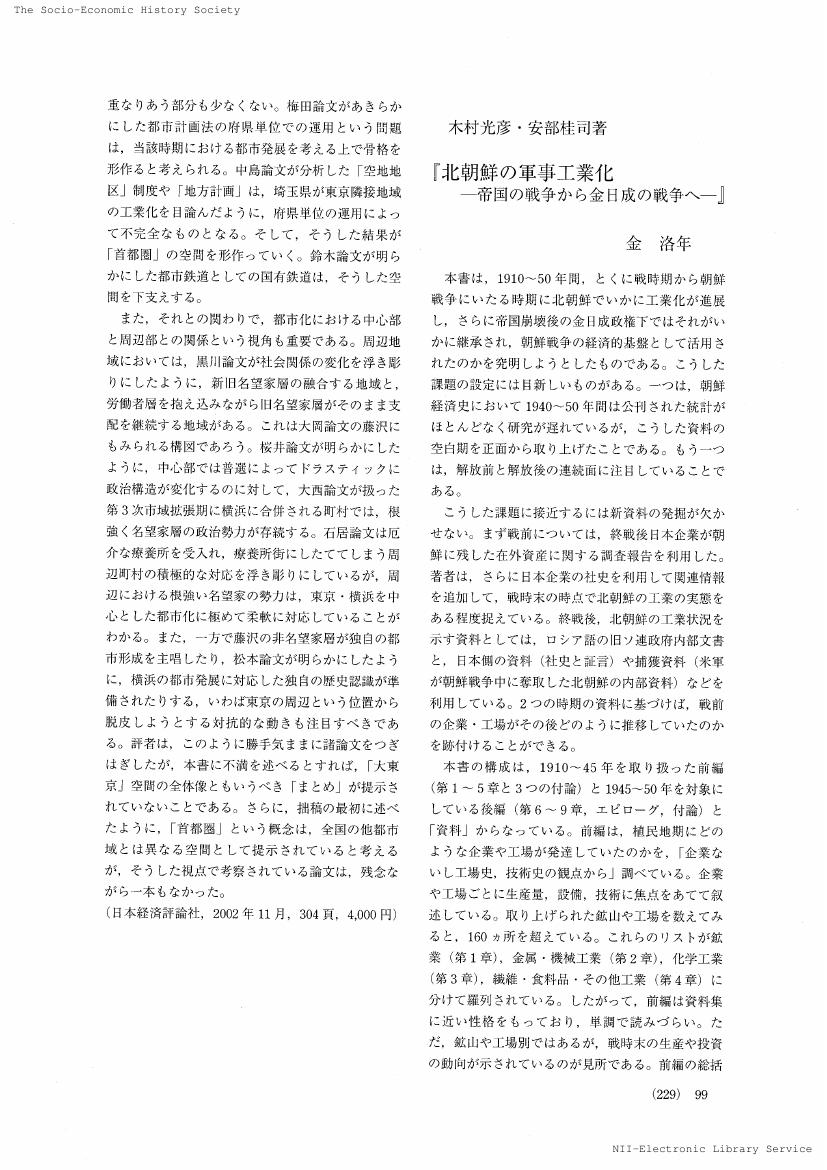48 0 0 0 植民地期における朝鮮・日本間の資金流出入
- 著者
- 金 洛年
- 出版者
- 土地制度史学会(現 政治経済学・経済史学会)
- 雑誌
- 土地制度史学 (ISSN:04933567)
- 巻号頁・発行日
- vol.34, no.3, pp.48-67, 1992
This paper elucidates one of the characteristic features of Japanese colonial rule over Korea, focusing on capital flows between the two economies. First, an attempt is made to estimate how much and in what sector capital investments were made from Japan to Korea in each phase of the colonial period. Based on these estimates significant findings include the followings: 1) In the early phase of colonial rule the Government-General took the lead in capital investments from Japan in areas such as railroad construction and the implementation of plans for increasing rice production. However, private direct investments increased rapidly beginning in the 1930s mainly in manufacturing and electric power industry. This process speeded up the transformation of the Koran economy into an integral part of the Japanese one. 2) During the Pacific War the financial institutions of Korea rapidly increased their purchases of securities, most of which were issued by Japanese government. This suggests that the role of financial institutions as principal agents of capital import was now reversed. 3) The increase of both capital inflows and outflows during the war indicates merely the transfer of purchasing power, which was not allowed to be realized by compulsory deposit and investment regulation policies. The result was a reallocation of resouces in Korea for war-related purposes. An attempt is also made to show how Japan could accelerate capital export to her colony. This paper emphasizes the role played by 1) the Korean monetary system, in which her currency was pegged to the Japanese one at an equal rate of exchange and in which the issue of the former is allowed on the basis of the latter, and by 2) the almost total dependence of Korea's trade structure on Japan. These two factors enabled Japan to accelerate capital export to Korea in spite of the shortage of foreign exchange reserves, particularly under the managed currency system. This resulted in expanded equilibrium within the Japanese colonial empire, as long as Japan's productive capacity was expanding. However, when it reached its upper limits during the war, Japan's capital exports under the trade control led to inflation in Korea.
10 0 0 0 OA 植民地期朝鮮の産米増殖計画と工業化
- 著者
- 金 洛年
- 出版者
- 土地制度史学会(現 政治経済学・経済史学会)
- 雑誌
- 土地制度史学 (ISSN:04933567)
- 巻号頁・発行日
- vol.37, no.2, pp.1-16, 1995-01-20 (Released:2017-12-30)
The purpose of this paper is to show how industrialization of Korea in the 1930s was influenced by the preceding agricultural development plans for increasing rice production (1920-34). Until now the rapid industrialization has been explained mainly by Japan's armaments-expanding policy in the 1930s. However this paper emphasizes internal factors created in the process of agricultural transformation in the 1920s. On the one hand, increase in rice production and its export to Japan at relatively high price produced an enormous surplus in the agricultural sector. This, in turn, enabled Korea to increase imports of manufatured goods. Through the agricultural development and trade with Japan, Korean economy could rapidly expand markets for manufactured goods beyond her production capacity. Later this expansion stimulated new rise and growth of many small-scale factories owned by Koreans or Japanese residents in Korea. Also it induced private direct investments from Japan to the manufaturing industry in Korea. This process promoted import substitution for manufactured goods. On the other hand, most of agricultural surplus fell into the pockets of large landlords and merchants who took the lead in rice production and export under landlord-tenant system. In order to examine whether agricultural surplus remained within the agricultural sector or was transferred to other sectors, we made access to the available lists of large landlords and stockholders, and examined the relationship between them. The results of this examination revealed that a lot of landlords not only took actively part in stock investment, but also established their own companies in non-agricultural sectors. In case of the companies owned by Koreans, it is estimated that more than one third of their capital was invested by landlords and one forth of their owners were also landlords. In short, agricultural development in the 1920s provided favorable conditions for the industrialization in Korea in the next decade in terms of domestic market expansion and capital formation.
- 著者
- 金 洛年
- 出版者
- 社会経済史学会
- 雑誌
- 社会経済史学 (ISSN:00380113)
- 巻号頁・発行日
- vol.70, no.2, pp.229-231, 2004-07-25 (Released:2017-08-09)
